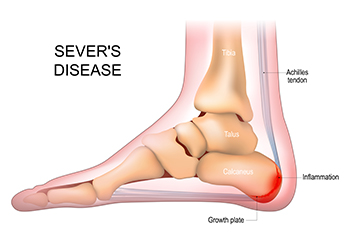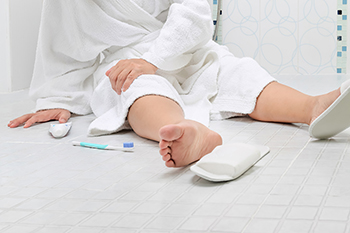Items filtered by date: August 2025
Heel Pain in Children

Sever’s disease is common of cause of heel pain in growing children and adolescents, as the result of inflammation of the growth plate in the heel bone. It typically occurs during growth spurts when the heel bone grows faster than surrounding muscles and tendons. Risk factors include high-impact activities like running and jumping, tight calf muscles, and wearing unsupportive footwear. Beyond heel pain, symptoms include swelling, limping, or discomfort during physical activity. A podiatrist can diagnose the condition, recommend stretching exercises, and suggest activity modifications, supportive footwear, or orthotics to relieve pressure. If your active child experiences persistent heel pain, it is suggested that you schedule a visit with a podiatrist who can accurately diagnose and treat the condition.
Sever's disease often occurs in children and teens. If your child is experiencing foot or ankle pain, see one of our podiatrists from Dr. Jeffrey J. Betman & Associates . Our doctors can treat your child’s foot and ankle needs.
Sever’s Disease
Sever’s disease is also known as calcaneal apophysitis, which is a medical condition that causes heel pain I none or both feet. The disease is known to affect children between the ages of 8 and 14.
Sever’s disease occurs when part of the child’s heel known as the growth plate (calcaneal epiphysis) is attached to the Achilles tendon. This area can suffer injury when the muscles and tendons of the growing foot do not keep pace with bone growth. Therefore, the constant pain which one experiences at the back of the heel will make the child unable to put any weight on the heel. The child is then forced to walk on their toes.
Symptoms
Acute pain – Pain associated with Sever’s disease is usually felt in the heel when the child engages in physical activity such as walking, jumping and or running.
Highly active – Children who are very active are among the most susceptible in experiencing Sever’s disease, because of the stress and tension placed on their feet.
If you have any questions, please feel free to contact our offices located in Northwest Chicago, Southwest Chicago, and Wicker Park, Chicago, IL . We offer the newest diagnostic and treatment technologies for all your foot and ankle injuries.
Protecting Your Feet With Falls Prevention Tips

Lowering the risk of falling is essential for maintaining mobility and preventing serious injuries, especially to the feet and ankles. Balance training can strengthen muscles and improve stability. Creating a safer home by removing loose rugs and improving lighting reduces tripping hazards. Having your vision checked and reviewing medications helps minimize dizziness and imbalance. Falls often lead to foot fractures, sprains, and lasting pain. A podiatrist can assess your foot structure, recommend supportive footwear, and offer guidance on fall prevention strategies. If you have sustained a fall and have injured your foot, it is suggested that you consult a podiatrist who can treat various foot conditions, and guide you on effective fall prevention techniques.
Preventing falls among the elderly is very important. If you are older and have fallen or fear that you are prone to falling, consult with one of our podiatrists from Dr. Jeffrey J. Betman & Associates . Our doctors will assess your condition and provide you with quality advice and care.
Every 11 seconds, an elderly American is being treated in an emergency room for a fall related injury. Falls are the leading cause of head and hip injuries for those 65 and older. Due to decreases in strength, balance, senses, and lack of awareness, elderly persons are very susceptible to falling. Thankfully, there are a number of things older persons can do to prevent falls.
How to Prevent Falls
Some effective methods that older persons can do to prevent falls include:
- Enrolling in strength and balance exercise program to increase balance and strength
- Periodically having your sight and hearing checked
- Discuss any medications you have with a doctor to see if it increases the risk of falling
- Clearing the house of falling hazards and installing devices like grab bars and railings
- Utilizing a walker or cane
- Wearing shoes that provide good support and cushioning
- Talking to family members about falling and increasing awareness
Falling can be a traumatic and embarrassing experience for elderly persons; this can make them less willing to leave the house, and less willing to talk to someone about their fears of falling. Doing such things, however, will increase the likelihood of tripping or losing one’s balance. Knowing the causes of falling and how to prevent them is the best way to mitigate the risk of serious injury.
If you have any questions, please feel free to contact our offices located in Northwest Chicago, Southwest Chicago, and Wicker Park, Chicago, IL . We offer the newest diagnostic and treatment technologies for all your foot care needs.
